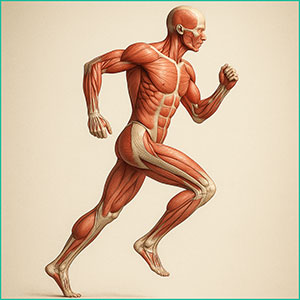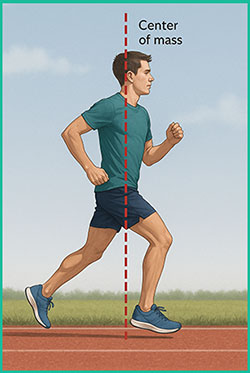Running Form Tips: Why Less Control Often Means Better Running... 💡
Do you find running form tips frustrating?
I’ve been there—everything from ChiRunning to the Pose Method, high knees and butt kicks; and yet tweaking the detail of my posture only lead to feeling stiff and sore after a run…
Sound familiar? You’re not alone...😉
Here’s the catch: the more you try to correct your mechanics, the more forced and unnatural your form becomes. That’s the paradox nobody warns you about.

This post offers a different approach. You’ll find practical, intelligent running tips that help you understand what is happening each time your foot hits the ground—and how to work with your body instead of against it.
By doing less, not more, you will uncover how ease, rhythm and relaxation lead to better form. No overthinking, no rigid rules—just subtle shifts that permit flow back into your stride. Let go of control, and let your body do what it already knows how to do…🏃
Note: The following page draws on core ideas in biomechanics and coaching—especially the distinction between passive and active motion, and how reflexes shape efficient running. Performance coach Steve Magness has helped bring many of these concepts into the mainstream and my thanks go out to him for much of the information made available on this page.
Passive vs. Active: What Should You Control?
One of the most important distinctions in running mechanics is between active and passive motion.
- Active: Muscles contract to make something happen consciously or automatically. Think: pushing off the ground
- Passive: Movement occurs through momentum, reflexes, or stored elastic energy. You didn’t make it happen directly; your body did it for you.
A good chunk of the running stride relies on passive mechanics. Trying to override them with muscular effort and conscious control will interfere with natural timing, waste energy, and increase the risk of injury. A surprising amount of the movement in running is reflex-driven, not effort-driven.
Let Reflexes Do Their Job
Take a heel flick during sprinting. It looks like the runner is pulling their foot up towards their backside. But in reality, it's the speed and force of the thigh swinging forward that makes the lower leg fold up. The faster the thigh accelerates, the more it drags the shin upward. It’s inertia, not intention.

The same goes for knee lift. You don't need to think about lifting your knees high. When your hip extends powerfully behind you, it stretches the muscles at the front of your hip. That stretch stores energy and when released it slingshots the thigh forward. The result? A fast, clean knee drive—no conscious lift required.
These are the kind of running form tips that help you understand why movement happens, not just what it looks like.
Use Arm Swing to Guide the Legs
Your arms play a key role in balance and rhythm. Pulling your arms back stretches the muscles at the front of the shoulders and chest. That stretch naturally rebounds and swings the arms forward. It's efficient, and it requires little effort.
Want to speed up? Focus on a slightly faster or longer backswing. Your legs will often match that rhythm automatically. The body balances itself through reciprocal motion: arms and legs counteract one another. If you fix one, the other follows.
Static Flexibility Isn't the Whole Story
Many runners assume that limited flexibility is a problem; but static flexibility (like touching your toes) doesn't predict how your body moves dynamically. Some of the most efficient runners in the world have poor scores on flexibility tests, yet demonstrate fluid, full-range motion when sprinting.
Why? Because a slightly stiffer muscle-tendon unit stores and releases energy like a spring. That’s a huge advantage when you're running. Looser isn’t always better. What matters most is your dynamic range of motion in motion, not how bendy you are on the floor.
Running Tips HQ:
Is Yoga for Runners? If performance matters, the answer might surprise you. Click here to find out… 😉
Running Form Tips: What To Focus On
Trying to copy someone else’s stride without understanding where their movement is coming from can do more harm than good. Instead, focus on setting up the right conditions for your natural reflexes and mechanics to take over. These running tips are about creating alignment, not mimicry. Here's where to put your attention:

👣 What to Focus On (Instead of Forcing Form)
- Lean from the ankles, not the waist
Keep your posture tall and aligned—head over hips over feet. A gentle forward lean from the ankles lets gravity do some of the work. - Land close to your centre
Forget heel vs. forefoot for now. Just aim to land with your foot roughly under your hips—that’s what keeps you from braking with every step. - Push from the hip, not the foot
The real drive comes from the hip. Think: push the ground away behind you, then let the leg swing through on its own. Don’t try to muscle it forward. - Let the arms set the beat
Your arms are your tempo guide. Focus on a strong, clean backswing—the forward motion will fall into place naturally. - Stay loose
Tension slows you down. Keep your jaw soft, shoulders easy, and hands relaxed—especially when the pace picks up.
Quick heads-up: Don’t try to use all the cues at once. Just pick one to focus on during a run—or even part of a run—and let it gently guide your awareness. You’re not aiming for perfect form, just creating the right conditions for it to happen naturally. Let your body do the rest.
These simple shifts are the foundation for a smarter running form. The goal is not to force movements, but to make space for them to happen...🔑
Running Tips HQ:
Increasing your running cadence (steps per minute) can help you land closer to your Centre of Mass and reduce overstriding. How? I used a digital metronome— Clip a metronome to your belt, set it just above your current cadence (e.g. 90 bpm per foot=180 steps per minute), and match one foot to each beep. Your rhythm adjusts naturally—no overthinking. I used one like this (opens a separate Amazon window)… 🏃
Final Word: Let Good Running Form Happen
The best running form tips aren’t about controlling every limb. They’re about understanding what not to control. Let reflexes and recoil do their job. Your role is to create the right setup—good posture = soft attention to running cues such as balanced arm swing or hip extension and apart from that you stay out of the way and let things happen.
Efficient running isn’t about looking a certain way. It’s about feeling fluid, using less effort, and moving in sync with your body’s natural design.
If you're looking to improve your stride, don't just follow the crowd. Dig deeper into what actually causes movement, and apply running form tips that work with your body, not against it.
Considering where to run can be highly motivating, allowing you vary your scenery and experience the benefits of running on different surfaces (more)
Can you already run 2 miles without gasping like a fish out of water? Great! You’re ready for our beginner 10k training plan. No more procrastinating—those miles won’t run themselves... (we checked)! 🏃♂️💨
|
Garmin Forerunner 55: Pro-level tracking—GPS, heart rate, running metrics—at a budget price. Smash goals, not your wallet. Ready to run? |
Ready to lighten your stride? Learn how to transition to minimalist running safely with our step-by-step training guide. Less shoe, more you! 🏃♀️👟>>>

